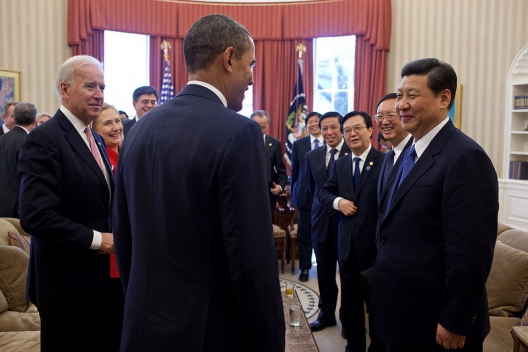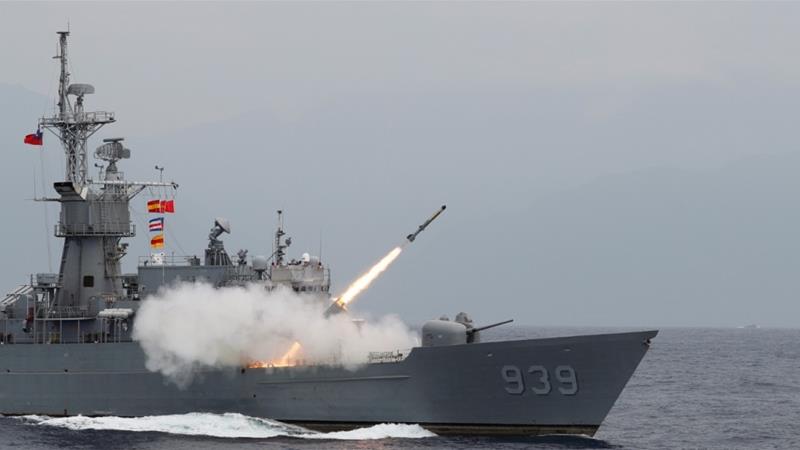There has been a good deal of saber-rattling in the South China Sea lately, with the Chinese People’s Liberation Army-Navy (PLA-N) conducting amphibious exercises and placing other pressure on Taiwan. This is of-a-piece with the aggressive goals of the People’s Republic of China to consolidate all territories containing Chinese citizens in its near-abroad into a “Greater China.” The former British crown colony of Hong Kong is well on its way to forced absorption into greater Communist China. And the Chinese Nationalists who fled the mainland after being defeated by Mao Tse-Tung’s Communist PLA forces in 1949 have always been the main Beijing target for being forcibly returned to Beijing’s control. Here is one report of recent PLA activity aimed at intimidating Taiwan:
For the fourth day in a row on Friday, warplanes from mainland China flew into airspace that considers its own, prompting the island’s air force to scramble jets to warn them off. It was the sixth such foray by a People’s Liberation Army warplane in less than a fortnight.
Earlier in the month, a dredger from the mainland sailed near the Taiwanese-administered island of Penghu in the Taiwan Strait and began mining for sand, also prompting the Taiwanese coastguard to go in to deter the vessel. The dredger is just one of about 1,200 mainland vessels that have operated in Taiwanese-administered waters since January, according to the island’s coastguard. Read more here
 Taiwan’s coastguard intercepts a flotilla of mainland Chinese sand dredgers on June 3. Photo: CNA
Taiwan’s coastguard intercepts a flotilla of mainland Chinese sand dredgers on June 3. Photo: CNA
In response, the US Navy deployed two carrier battle groups to the area as a major show of force and deterrent to increased PLA aggression, as noted here:
As tensions between Beijing and Washington continue to simmer regarding who owns the South China Sea, the U.S. aircraft carriers Nimitz and Ronald Reagan conducted rare dual-carrier operations there this past weekend. China has increasingly sought to cast the South China Sea as its maritime domain, and the U.S. Navy has responded by sailing vessels through those waters to reinforce the fact that they are international.
The two carriers launched fighter jets “around the clock,” while practicing other skills in tandem, according to a Navy release. They were joined in the skies by an Air Force B-52 Stratofortress, a long-range, nuclear-capable bomber from the 2nd Bomb Wing from Barksdale Air Force Base, Louisiana.
Read more about the two-carrier operation here.
But Chicom saber-rattling extends into other parts of the South China Sea, too, as noted by the Belfer Center:
[M]ost nations have a direct stake in ensuring that freedom of navigation is respected in the South China Sea. Unfortunately, however, the SCS is home to a number of longstanding territorial disputes. Brunei, China, Indonesia, Malaysia, the Philippines, Taiwan and Vietnam have overlapping sovereignty claims to various maritime features and areas of water in the SCS.
Most of these territorial disputes center on features located in the Paracel and Spratly island groups.
In order to reinforce territorial claims, several states occupy features in the South China Sea, and some [especially China] have reclaimed land, built infrastructure (e.g., airfields, hangers, docks), and stationed troops and military hardware on these features. Their actions have raised concerns over the possibility of conflict and the increased capabilities of states to limit navigation in the region.
Although several states have engaged in such activities, the amount of reclamation and construction undertaken by China, as well as the degree of militarization of features it occupies, has raised particular concern.
Read more about international competition in the South China Sea here.
Chicom militarization in the South China Sea indeed! Here is what they’re specifically up to in terms of militarizing some of the disputed islands in the region while the rest of the world is focused on fighting the Chicom virus:
At the present moment, China has runways and dozens of hangars for fighter aircraft on a handful of islands, as well as anti-ship cruise missiles, anti-aircraft batteries and missile defenses. The Chinese have used these islands to begin pressure campaigns in the Spratlys, Paracels and even the Natuna Sea (claimed by Indonesia).
Though they have refrained from mass fighter deployments to their island bases, in the event of a conflict, fighter squadrons would potentially be able to rapidly mobilize and use the hardened facilities as forward basing. The Chinese could then use the recently installed anti-ship, missile and air defenses to limit incursions into the South China Sea, effectively keeping an adversary at bay during an onset of hostilities. In effect, these islands should be considered an existential threat to Taiwan, since they mitigate the U.S.-led deterrence against an attempt at unification by force.
The islands afford China bases from which it can intimidate ASEAN states into abandoning their claims or acquiescing to Chinese demands. China’s paramilitary forces and fishing vessels use the island bases as hubs from which to harass and even sink commercial ships from ASEAN countries. A coordinated, international response is necessary to curtail the success of China’s Monroe-esque Doctrine throughout Asia.
Read more about the implications of Chinese militarization in the South China Sea here.
Increasing PLA-N deployments in the region are awakening a sleeping giant that has been slumbering since World War-II: Japan. The Chinese and Japanese have been uneasy neighbors, historical competitors, and often open enemies for at least two millennia. The peace imposed on Japan after their defeat in WW-II restricted Japanese armed forces to self-defense capabilities. In fact, their military is even called the Japan Self-Defense Force, with the naval element entitled the Japan Maritime Self-Defense Force.
The Japanese have been watching China’s rise with great concern since President Nixon and Henry Kissinger “opened” China in 1972. That rise has included a massive expansion of PLA and PLA-N capabilities: satellites, ships, aircraft, cruise, and ballistic missiles, etc. The Japanese response to Chicom military expansion has been measured, but there are signs that Japan’s National Diet (their bicameral legislature) may approve the development and deployment of first-strike weapons as deterrents to potential future Chicom aggression, either directly by the PLA or by its vassal state North Korea:
Japanese Defense Minister Taro Kono, however, did not rule out the possibility of replacing the missile defense system with first-strike weapons in order to tackle the increasing threat from North Korea and China. Implementation of any first-strike capability would signal a fundamental shift in Japan’s military policies. The aims for first-strike capability are actually in synergy with Prime Minister Shinzo Abe’s goal to amend Japan’s pacifist constitution, by rewriting the war-deterring Article 9 that, if read literally, prohibits Japan from amassing war-making “potential.”
Beijing’s continuing assertive behavior in the East and South China Seas and its recent standoffs with India have alarmed Japan. The detection of a foreign submarine, likely Chinese, off the island of Amami Oshima in June and China’s putting into service two nuclear submarines in April have increased Japan’s concerns.
Read more about the Japanese internal debate about developing first-strike deterrent capabilities here.
In the next 10-15 years, as the pervasive China military threat and its aggressive hegemonistic policies accelerate, and as North Korean nuclear missile threat grows, we may regardless see a diminishing of US military commitments to Japan and South Korea. This would almost certainly happen in a Biden Administration, which would undoubtedly return to the Chicom appeasement policies of the Obama and Clinton years.
If so, both Japan and the Republic of Korea would probably make the ultimate leap in capabilities for their own independent security by developing (or acquiring) and deploying first-strike missile capabilities. Both Japan and the ROK are threshold nuclear states that could rapidly generate dozens of nuclear warheads within two years from a political decision made to develop and deploy them. Both Japan and the ROK have successful civilian space programs with reliable space launch vehicles that can readily be turned into medium-range and intermediate-range ballistic missile (MRBM/IRBM) programs.
It is entirely predictable that Japan's anti-nuclear constitution (mentioned above) and the Japanese population's historical hatred of nuclear weapons as the only country that has ever sustained a nuclear strike in wartime will erode rapidly once the last vestiges of the World War-II Hiroshima/Nagasaki generation passes on. The younger generations will care more about the immediate Democratic People’s Republic of Korea (DPRK) and PRC threats than about hazy memories of nuclear attacks 80 or 90 years ago. If (heaven forbid) the US returns to appeasement of Communist China in a Biden Administration, then the Japanese and South Koreans will surely make their own conclusions about their need for nuclear umbrellas.
And lurking in the background is Taiwan, another threshold nuclear state – always on the precarious edge of PRC military invasion, as noted by the recent Chicom saber-rattling described above. Taiwan also has a small but high-tech civilian space program that could quickly create a small nuclear MRBM/IRBM deterrence force, should they not trust in American backup against China's "final solution" to absorb Taiwan into the PRC by force.
There are many more "interesting times" ahead in East Asia, as US power and commitments in the Pacific slowly dissipate while America continues to be distracted by domestic political strife, alliances shift, an arms race in East Asia commences in earnest, and old enemies potentially renew their enmity in unforeseen ways.
This is definitely NOT the time for the US to usher in another Democrat administration to appease Communist China! Vote wisely in November.
Stu Cvrk served 30 years in the US Navy in a variety of active and reserve capacities, with considerable operational experience in the Middle East and the Western Pacific. An oceanographer and systems analyst through education and experience, Stu is a graduate of the US Naval Academy, where he received a classical liberal education. This functions as the key foundation for his political commentary. He threads daily on Twitter on a wide range of political topics, such as the military, foreign policy, government, economics, and world affairs.
Twitter: @STUinSD
Web: stuinsd.net





